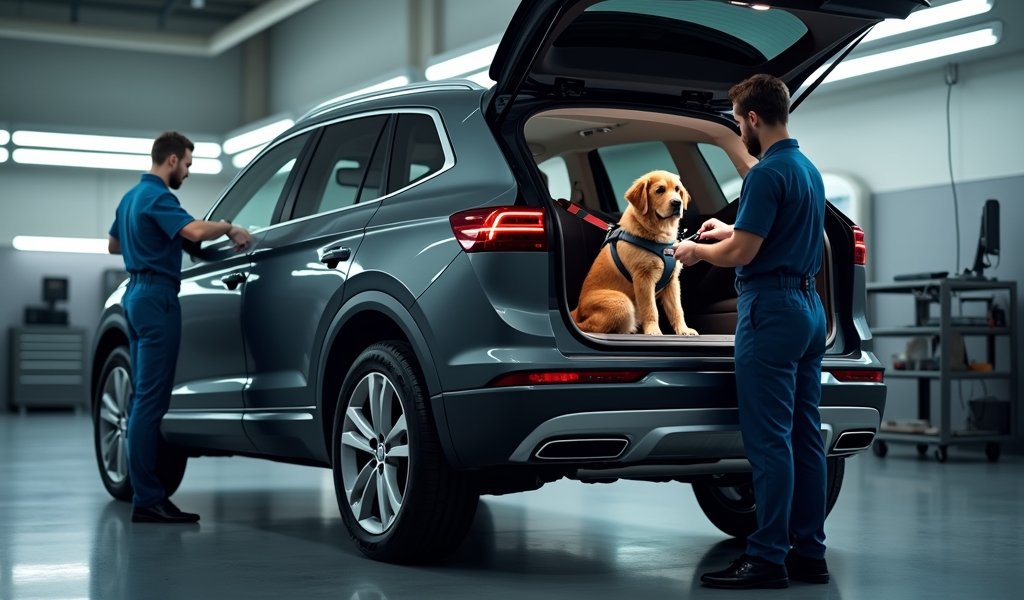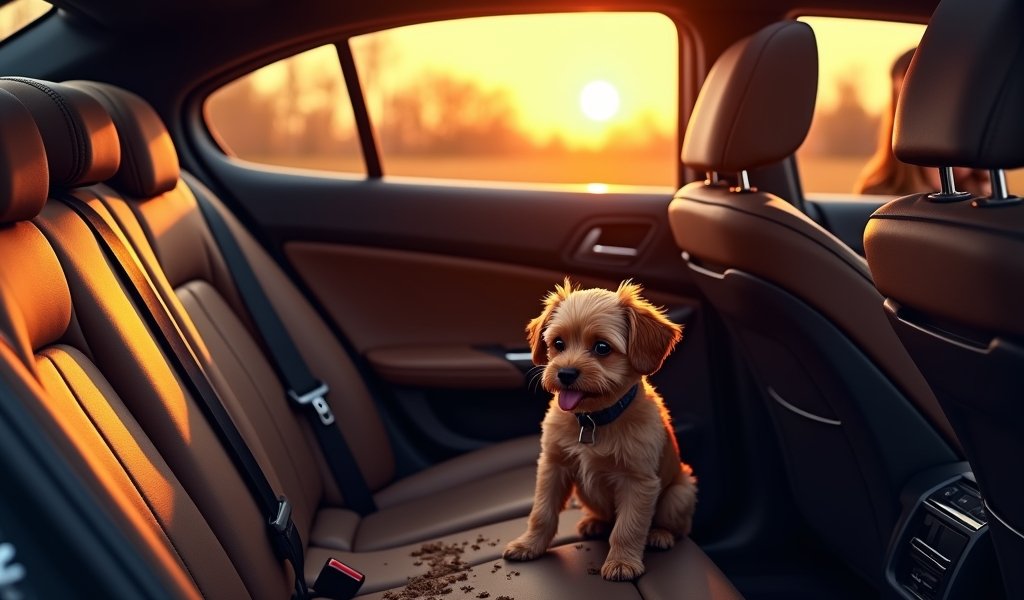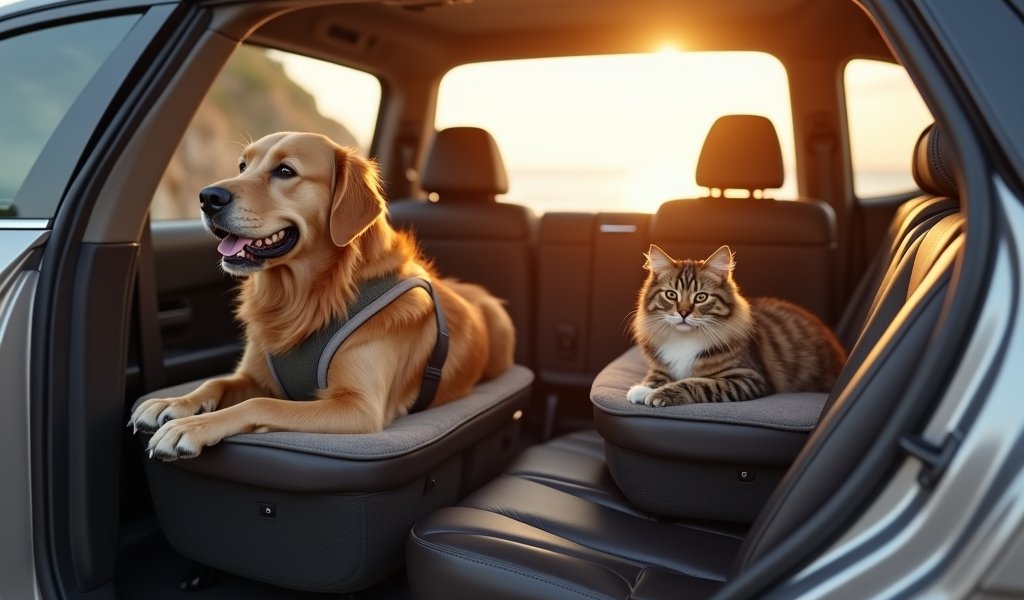Overview
The article outlines seven essential pet car safety treatments including proper restraint systems, window treatments, floor protection, emergency preparedness, cleanliness measures, and behavioral training to ensure safe pet travel. These solutions protect both pets and vehicles during travel while addressing key concerns like temperature control, secure containment, and accident prevention for responsible pet transportation.
Table of Contents
- Introduction to Pet Car Safety
- Why Pet Car Safety Matters
- Pet Restraint Systems: The First Line of Defense
- Window Treatments and Temperature Control
- Floor and Seat Protection Solutions
- Emergency Preparedness for Pet Travel
- Maintaining Cleanliness and Odor Control
- Training Your Pet for Car Travel
- Conclusion
- Frequently Asked Questions
Introduction to Pet Car Safety
Pet car safety isn’t just a luxury—it’s a necessity for every responsible pet parent who travels with their furry companions. As someone who’s spent over 15 years working on vehicles and designing custom pet-friendly modifications, I’ve seen firsthand how the right auto treatments can make all the difference between a stressful journey and a pleasant one. Whether you’re taking your dog to the vet or embarking on a cross-country adventure with your cat, these proven solutions can protect both your beloved pet and your vehicle’s interior.
Throughout my career, I’ve helped countless pet owners transform their vehicles into safe havens for animal transport. The seven treatments we’ll explore today represent the gold standard in pet car safety—solutions that address everything from restraint systems to emergency preparedness. And the best part? Most of these modifications can be implemented without extensive mechanical knowledge or breaking the bank.
Let’s dive into these game-changing auto treatments that will revolutionize how you travel with your four-legged family members.
Why Pet Car Safety Matters
Before we explore specific solutions, let’s talk about why pet car safety deserves your attention. An unrestrained 10-pound dog in a 30 mph collision generates roughly 300 pounds of force—imagine what that means for a larger breed. According to a study published in the National Library of Medicine, pets can become dangerous projectiles during accidents, threatening not only their own lives but also those of human passengers.
Beyond collision safety, there are other concerns to address. Temperature fluctuations can quickly become dangerous for pets. A vehicle’s interior can reach 104°F within just 30 minutes on a 75°F day—a potentially fatal environment for animals left unattended. Additionally, anxious pets can damage your car’s interior, creating costly repairs and potentially dangerous distractions while driving.
Consider this sobering fact: approximately 84% of pet owners don’t properly secure their animals during car travel. Yet implementing proper pet car safety measures not only protects your furry friend but also preserves your vehicle’s value and ensures legal compliance, as some jurisdictions have specific requirements for pet transportation.

Pet Restraint Systems: The First Line of Defense
When it comes to pet car safety, proper restraint systems top my list of essential auto treatments. After years in the garage seeing the aftermath of pets injured during minor fender benders, I can’t stress this enough—securing your pet isn’t optional, it’s fundamental.
Let’s break down your main options:
- Pet Harnesses with Seat Belt Attachments: These work similarly to human seat belts, distributing force across the strongest parts of your pet’s body during sudden stops. Look for crash-tested models with wide, padded straps that connect to your vehicle’s existing seat belt system.
- Travel Carriers and Crates: Particularly ideal for smaller pets and cats, a secure travel carrier for your cat offers both physical protection and psychological comfort. Hard-sided carriers provide more structural protection in crashes but ensure whatever you choose can be securely strapped to the vehicle.
- Vehicle Pet Barriers: These keep pets confined to the cargo area in SUVs and station wagons, preventing them from distracting you while driving. Metal barriers typically offer superior protection compared to mesh alternatives.
When selecting a restraint system, consider your pet’s size, temperament, and the type of vehicle you own. For example, a 75-pound Labrador needs a heavy-duty harness with reinforced stitching, while a Chihuahua might be better served by a secure, padded carrier.
Remember that restraint systems serve a dual purpose: they protect your pet during accidents and prevent them from becoming a dangerous distraction. Even the most well-behaved pet can become startled and interfere with your driving. In fact, a survey by AAA found that 65% of dog owners admit to engaging in distracting activities with their pets while driving.
Installation tips: Always follow manufacturer instructions precisely. For harnesses, ensure a snug but comfortable fit where you can slip two fingers between the harness and your pet. For carriers, position them away from airbag deployment zones, ideally in the back seat secured with a seat belt.
Window Treatments and Temperature Control
Controlling your vehicle’s internal environment is crucial for pet car safety. I’ve repaired many vehicles with damaged interiors from pets overheating or becoming anxious due to excessive sunlight and temperature fluctuations. Fortunately, several effective window treatments can address these issues.
Window tinting is perhaps the most effective permanent solution. A quality ceramic tint can block 99% of UV rays and reduce heat buildup by up to 60%. This isn’t just about comfort—it prevents your pet from suffering heat stress and protects your interior from sun damage. When selecting a tint, opt for a ceramic or carbon variant rather than dyed films, as they provide superior heat rejection without interfering with electronic signals.
If permanent tinting isn’t an option, consider these alternatives:
- Removable Mesh Window Shades: These allow airflow while blocking direct sunlight and providing privacy. They’re particularly useful for side windows where your pet might be seated.
- Retractable Window Screens: These can be deployed when needed and store away when not in use, offering flexibility for different driving conditions.
- Sunshades for Parked Vehicles: A reflective windshield shade and side window covers can dramatically reduce heat buildup when your vehicle is parked.
Beyond window treatments, consider supplemental cooling options. A small battery-powered fan secured to your pet’s carrier can improve air circulation. For longer trips, portable cooling mats that remain cold for several hours provide relief from heat. These pet car accessories can make a significant difference in your pet’s comfort level.
Temperature monitoring has also become more sophisticated. Several apps work with Bluetooth thermometers to alert you if your vehicle exceeds safe temperature thresholds. While these should never be used as an excuse to leave pets unattended in vehicles, they provide an additional safety layer during brief stops when someone remains with the pet.
Remember, even with these treatments, never leave your pet alone in a vehicle. According to the American Veterinary Medical Association, the temperature inside a car can rise nearly 20 degrees in just 10 minutes, creating potentially fatal conditions even on mild days.
Floor and Seat Protection Solutions
Protecting your vehicle’s interior isn’t just about maintaining resale value—it’s also about creating a safe, hygienic environment for both you and your pet. After years of restoring pet-damaged vehicle interiors, I can tell you that prevention is infinitely easier than repair.
Waterproof seat covers designed specifically for pets are your first line of defense. The best options feature:
- Multi-layer construction with waterproof barriers
- Non-slip backing to prevent shifting during travel
- Reinforced seams that won’t tear under pet claws
- Machine-washable materials for easy cleaning
Hammock-style designs that extend from the front to back headrests create a protective cocoon that catches hair and prevents your pet from falling into the footwell during sudden stops. Many quality car seat covers for pets also incorporate storage pockets for supplies and side flaps that protect door panels from scratches.
For the floor area, consider rubber or silicone floor liners custom-fitted to your vehicle model. Unlike standard carpeted mats, these contain spills and mud within raised edges and can be easily removed for cleaning. Some advanced versions feature antimicrobial treatments that inhibit odor-causing bacteria—a significant benefit for long-term pet transport.
If you frequently transport pets in a cargo area, invest in a cargo liner with a bumper flap extension. This protects both the cargo floor and the bumper during loading and unloading. Look for models with built-in barriers that prevent liquids from seeping into seat gaps or door sills.
Installation tip: Before applying any seat or floor protection, thoroughly clean the surfaces with an enzymatic cleaner designed for pet odors. This eliminates any existing scent markers that might encourage your pet to “remark” the area. Once installed, secure all covers according to manufacturer specifications to prevent dangerous shifting during travel.

Emergency Preparedness for Pet Travel
In my years working with vehicles, I’ve learned that preparation for the unexpected is what separates responsible pet owners from the rest. Emergency preparedness isn’t just another aspect of pet car safety—it’s a critical component that could save your pet’s life during an unexpected situation.
Every pet-friendly vehicle should contain a dedicated emergency kit. Here’s what I recommend including:
- Pet First Aid Supplies: Gauze pads, adhesive tape, hydrogen peroxide, styptic powder for nail bleeding, digital thermometer, tweezers, and scissors.
- Hydration and Nutrition: Collapsible water bowls, bottled water (replaced regularly), and a 3-day supply of your pet’s regular food in a waterproof container.
- Documentation: Waterproof container with vaccination records, medication lists, your vet’s contact information, and recent photos of your pet (useful if they become lost).
- Temperature Management: Emergency thermal blankets that can provide warmth or reflect heat depending on conditions.
- Restraint Backups: Extra leash, collapsible carrier, or temporary harness in case primary equipment is damaged.
According to guidelines from the American Veterinary Medical Association, pets should wear collars with ID tags at all times during travel. Consider adding a temporary travel tag with your destination address and contact information for extended trips.
For tech-savvy pet owners, several GPS tracking devices can attach to your pet’s collar and sync with smartphone apps. These provide real-time location data should your pet escape during an accident or emergency stop. Some advanced models even monitor vital signs and activity levels.
Finally, map out emergency vet locations along your route for longer journeys. Several smartphone apps can help you locate 24-hour veterinary facilities anywhere in the country. Having this information readily available can save precious minutes during a critical situation.
Remember to check your emergency supplies regularly—at least before each major trip—to ensure medications haven’t expired, food remains fresh, and all documentation is current.
Maintaining Cleanliness and Odor Control
After decades in automotive work, I’ve seen how pet-related cleanliness issues can escalate from minor nuisances to serious problems affecting vehicle value and even driving safety. Implementing proper cleanliness systems isn’t just about appearances—it’s an essential aspect of pet car safety that prevents distraction and maintains healthy air quality.
Let’s start with fur management. Pet hair can clog ventilation systems, create respiratory irritants, and work its way into mechanical components. I recommend keeping these tools in your vehicle:
- Silicone pet hair removal brushes that won’t damage upholstery
- Handheld vacuum with pet-specific attachments
- Lint rollers for quick cleanup between thorough cleanings
- Microfiber cloths that trap hair without spreading it around
For odor control, avoid masking sprays that simply cover up smells. Instead, implement a multi-layer approach:
- Enzymatic Cleaners: These break down organic matter at the molecular level, eliminating odors at their source rather than just covering them.
- Activated Charcoal Bags: Placed under seats, these natural odor absorbers pull smells from the air without introducing chemicals.
- HEPA Cabin Air Filters: Upgrade your vehicle’s standard cabin air filter to a HEPA version that captures dander, hair, and odor-causing particles.
- Regular Maintenance Schedule: Establish a weekly quick-clean routine and monthly deep-clean protocol.
For accident cleanup, time is of the essence. Keep an emergency cleaning kit containing absorbent towels, enzymatic spray, disposable gloves, and sealed bags for waste. Address accidents immediately to prevent liquids from penetrating to padding beneath upholstery where they become nearly impossible to remove completely.
Preventative measures are equally important. Consider scheduling professional detailing that includes extraction cleaning every six months if you frequently travel with pets. Some detailing services now offer pet-specific treatments that apply protective coatings to surfaces, making future cleanups easier.
Remember that a clean vehicle isn’t just more pleasant—it’s safer. Airborne pet hair and dander can trigger allergic reactions or respiratory issues that distract from driving. Clean windows and mirrors ensure clear visibility, and odor-free environments reduce driver fatigue on longer journeys.
Training Your Pet for Car Travel
The most sophisticated pet car safety equipment in the world can’t replace proper training. As a mechanic who’s also a devoted pet owner, I’ve learned that preparation begins long before the key enters the ignition. Behavioral conditioning is arguably the most overlooked “auto treatment” for pet travel safety.
Start with short, positive exposures to the vehicle without actually driving. Let your pet explore the car while it’s parked in a familiar location. Reward calm behavior with treats and affection, creating positive associations with the vehicle environment. For anxious pets, try using their favorite blanket or toy to establish a sense of security.
When you’re ready to begin actual travel training, follow this progressive approach:
- Phase 1: Very short drives (around the block) with another person attending to your pet’s needs
- Phase 2: 10-15 minute drives to pleasant destinations (not just the vet!)
- Phase 3: Longer journeys with planned breaks every 2 hours
- Phase 4: Full travel experiences with confident, calm behavior
During training, maintain consistent rules and boundaries. If your pet won’t be allowed on certain seats during actual travel, don’t make exceptions during training. Use the same restraint systems consistently so they become part of the normal routine rather than stress-inducing novelties.
For pets with moderate anxiety, several natural calming aids can help without causing drowsiness:
- Thunder shirts or anxiety wraps that provide gentle pressure
- Pheromone sprays or diffusers designed specifically for cars
- Classical music or audiobooks that mask road noise
Severe anxiety might require consultation with a veterinarian who can recommend appropriate behavioral medications for travel. Never medicate your pet without professional guidance, as improper dosing can create serious health risks.
Remember that successful training requires patience and consistency. Some pets adapt quickly to car travel, while others need weeks or months of gradual exposure. The investment in proper training pays dividends in reduced stress for both you and your pet during future journeys.
Conclusion
Pet car safety isn’t just about checking boxes—it’s about creating a comprehensive system that protects your furry family members in all circumstances. By implementing these seven proven auto treatments—proper restraint systems, window treatments, floor and seat protection, emergency preparedness tools, cleanliness protocols, and thorough training—you’re creating a vehicle environment that maximizes safety while minimizing stress.
Remember that these treatments work best as an integrated system rather than isolated solutions. A well-restrained pet in a temperature-controlled environment with proper emergency supplies represents the gold standard in pet car safety. Start with the treatments most critical for your specific pet and vehicle, then gradually implement the complete system.
As both a mechanic and a pet lover, I can tell you that the time and resources invested in proper pet car safety pay enormous dividends—not just in preventing accidents and property damage, but in creating genuinely enjoyable travel experiences that strengthen the bond with your furry companions. Safe travels to you and your pets!
Frequently Asked Questions
What’s the safest place for my pet in the car?
The back seat or cargo area with proper restraints is safest. Front seats are dangerous due to airbags that can injure pets during deployment.
Are pet car seats worth the investment?
Yes, for smaller dogs (under 30 pounds), as they elevate pets for better view while containing them safely. Ensure they’re used with proper harness attachments, not collar connections.
How often should I take breaks when traveling with pets?
Stop every 2-3 hours for water, bathroom breaks, and short walks. This prevents anxiety, motion sickness, and bladder issues during longer journeys.
Can I use a regular leash as a car restraint?
Never use regular leashes as car restraints. They can cause severe injury or strangulation during sudden stops and don’t provide proper crash protection.
How can I prevent my pet from getting carsick?
Travel on an empty stomach (feed 3-4 hours before departure), ensure good ventilation, and limit visual stimulation by positioning pets to face forward. For chronic cases, consult your vet about anti-nausea medications.


Pingback: Dog Car Harness: 5 Best Safety Picks - knowsyourcar.com